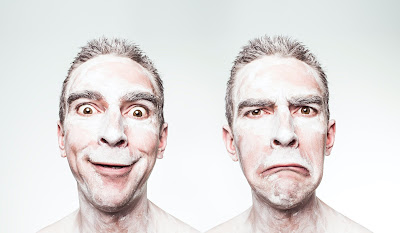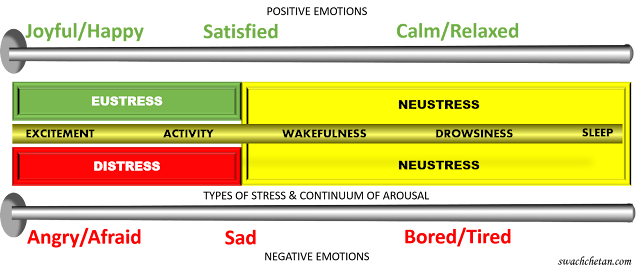How are Emotions connected to Stress?
Emotions have become an important part of our lives. People often say that they can’t live without emotions and that emotions are natural. Do we need stress to be emotional? In such a case, what happens when we are happy? Are we stressed even then?
How do animals react emotionally?
Let us
take a deer living in a forest, for example.
It is under physical threat almost all the time and it is under distress
each time it is under attack. This
distress leads to a state of heightened arousal in the body called a fight or
flight reaction. Depending upon how the
deer perceives the threat, this arousal can be called anger or fear. If another deer attacks it, then it may react
with anger. Otherwise, when it is
attacked by a tiger, it may react with fear.
Corresponding to the emotions several bodily changes occur in the animal. For example, changes may occur in the autonomic nervous system, hormonal secretions, body posture, sensation, perception, visceral functions, etc.
In addition, more blood and oxygen are pumped into the limbs so that extra energy is present to engage in either fight or flight. This is nature’s way of equipping the organism to ward off the threat to survival.
Note that these emotions are absent when we go to sleep. Or we can't sleep in the presence of these emotions.
Are the parameters similar in humans?
A similar
occurrence is there among human beings, too.
However, in our day-to-day
environment, we are not attacked by anyone and there is no threat to our
survival. Let us take the case of a student, for instance. S/He wakes up in the
morning in her/his own house, gets ready to go to school, and eats breakfast
that is prepared; takes a van or bus to school and returns the same way; in
short, stays protected for the whole day.
Technically, there is no chance for
her/him either to get angry or afraid because s/he is not under attack at any
point in time.
In reality, most of our lives are characterized by anger and fear. However, the object of these emotions is absent! We don't know what we are angry or afraid about. So we pick on something or the other.
Arousal of Emotions
Arousal is a stirred-up physiological and psychological state in the individual.
Emotions are aroused in us for several reasons
- To communicate our feelings to others
- To enable us to react to the situations around us
- To protect us from harm during emergency
- To ensure our survival by procuring food and eliminating the threat
Why Negative Emotions?
We have negative emotions even when they are not needed. This is because we associate a neutral stimulus with an emotionally charged one and over time even the neutral stimulus becomes a threat to us.
Thus,
we are angry at our people, we quarrel with friends and relatives, we are
afraid of people who we know will not hurt us in any manner, we are sad almost on
every other occasion, and we are jealous of others because they possess
something we don’t have.
The
time and energy we invest in learning negative emotions are too much and this
reflects in our behavior.
Two aspects of emotions
The first aspect of emotion is the Emotional
Experience. We have a wide range of experiences like pleasure and
displeasure, happiness and sadness, euphoria and depression, etc. Thus, there
are two distinct types of emotional experience – enjoyment versus tension.
The
second aspect of emotion is Emotional Expression. Our expression also
ranges from jubilation to crying, worrying, anxiety, weeping, aggression, etc.
Thus, there are two distinct types of emotional expression here: merriment
versus attack/withdrawal.
Physiological changes occur in both experience and expression in terms of changes in the autonomic nervous system, arousal mechanisms, blood supply, oxygen supply, bodily postures, facial expressions, sounds, bodily strength, perceptual mechanisms, thought processes, etc.
Some of these changes are accessible to our consciousness and some are not.
Non-compatibility of the two aspects
With
human beings, these two aspects of emotions are like two sides of the same
coin. When one side is visible, the other side is hidden, almost all the time.
In rare instances, both sides may be visible.
Emotional experience varies
according to the situation and the level of stress. For example, when we are
admonished, our experience depends upon how threatening we consider the
situation. The way we take in when the boss scolds us is not the same as when a
friend or a stranger scolds us.
Similarly, our reaction to the situation also changes, depending upon the situation. For example,
- We may get angry when the boss scolds us but we may not show it in front of him/her.
- We may not be angry when a stranger scolds us but we may show it in front of him/her.
Emotions are offshoots of stress
Emotions
are neither independent of stress, nor a concomitant of stress. Emotions are
manifestations of stress. If not for emotions, we will never know we are
stressed. Emotions are warning signals that the individual is under stress,
similar to headaches or fever when the body needs to be mended. Thus, emotions
are symptoms of stress.
For emotions to be either
experienced or expressed, the increase in stress is a necessary condition.
During Eustress, positive emotions are experienced and/or expressed, and
during Distress, negative emotions are experienced and/or expressed.
During Neustress, there is a balance between positive and negative
emotions, and the experience and expression of both are controlled.
Stress gets heightened in both eustress and distress
Stress
is higher in both positive and negative emotional states. As pointed out here (MANAGE STRESS), the arousal level is
high in both eustress and distress. This arousal level is necessary for the
onset of emotions, be it experiencing them or expressing them.
We aspire more for positive emotions, basically because, most of the time we are in distress. To balance the heightened distress, we try entertainment, adventure, celebration, therapy, etc. However, these are temporary fixes as they stay with us for a very short time and we revert to our distress. Hence, the solution is to spend less time, energy, and resources in learning how to be distressed.
Distress gets rewarded more than eustress
We
spend most of our time in distress simply because, distress is encouraged by
everyone. The moment you plan to be happy, people put in a lot of ideas as to
how what you are about to do could be dangerous to you or others.
Negative
emotions can be more easily manipulated than neustress or eustress. People can
notice your distress and can influence your behavior. It is easier to make
someone angry or afraid, rather than make them happy.
Negative emotions can be prolonged for a great amount of time. You can’t be happy throughout the day but be sad, angry, or afraid.
In short, people think that stress means tension and may claim that they are not under stress. As pointed out elsewhere, stress is present all the time in our lives. We cannot live without stress. But whether it is eustress or distress, we will know when we have corresponding emotions.
Pain or pleasure is a symptom of Physical Stress
Negative or Positive Emotion is a symptom of Mental Stress
Aches and pains are only symptoms of an underlying problem and not the problem itself. The pain is trying to inform us that there is something wrong with a tissue, organ, or system in the body and our primary concern would be to first remove the problem so that the symptom goes away.
Similarly, emotions are only symptoms of an underlying problem and not the problem itself. The emotion is trying to inform us that there is something we need to attend to, which needs a higher degree of stress. We should first attend to the mental stress so that the emotion will go away.














Please do not include any spam links in the comment box.